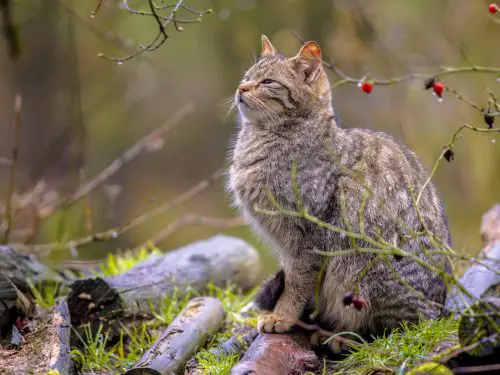You may be wondering if groundhogs can harm your cat. Here’s some information: Are groundhogs, predators? And do other animals attack cats? If so, why? Read on to learn more. Are groundhogs dangerous to cats? And how do you protect your cat from them? Below, you’ll find answers to these questions and more. So, what animals are the most dangerous to cats? And which ones are the most likely to attack your cat?

Will Groundhogs Attack Cats?
Groundhogs can be dangerous, but they’re not necessarily aggressive to big cats. But if it gets to a fight your cat or kitten can get hurt. But if it has the chance it could attack a small kitten so make sure to keep an eye out f you have your small kitten out playing. If you’d like to avoid the problem, you can take steps to keep the animal out of your yard. If possible, remove attractants, such as twigs or rotting leaves. You can also install fences and other exclusion devices to keep the animals out. While most groundhogs don’t pose a threat to your pets, be aware that you’ll have them in semi-urban and rural areas.
If you’re concerned about the threat to your cat, you can try to scare groundhogs away by placing Epsom salts in a pewter pie plate. Alternatively, you can sprinkle salt on the groundhog’s trail. But remember that a groundhog is not likely to attack your cat intentionally if you’re keeping it on your property. Groundhogs are more likely to target a large, strong dog than a small, weak cat.
If you think that a groundhog will attack your cat, you should keep it away from its food source. Groundhogs eat tiny kittens, owls, possums, and other creatures. They can also be scared of strong scents, so don’t use those either. Several herbs, such as lavender, are not good for groundhogs. If the groundhogs persist, you can try spraying a repellent made of lavender on your yard or in the garden.
Despite their reputation as nuisances, groundhogs play an important role in the ecosystem. Their burrows can become homes for other animals. Groundhogs also aerate the soil and recycle nutrients. And unlike some other pests, they do not reproduce quickly. Female groundhogs carry their young for up to a month and give birth to two to six pups. This means that groundhogs will not attack your cat immediately, but if you do see a groundhog in your yard, don’t hesitate to call the pest control authorities.
Are Groundhogs Predators?
Groundhogs are one of 14 species of marmot, and they are often confused with woodchucks. They are also known as ground chucks, woodchucks, or whistlers. They do not typically attack humans, but they will eat other animals that come too close. While the groundhog is a pest, there are some steps you can take to protect it. Here are a few tips:
The first thing you should know is that groundhogs do not actively seek out predators. While their sharp claws and teeth are always ready to pounce on their prey, they would much rather stay in their burrows. However, when they do come outside, they are on high alert. They stay still and stand almost motionless on their hind legs, and they release their trademark whistles when they sense danger.
Female groundhogs usually hibernate in their burrows during the winter. In early spring, they emerge from their dens to mate and give birth to one to five babies. The young groundhogs, known as chucklings, reach sexual maturity at two years of age. While they live between three and six years in the wild, they have been known to get fourteen years in captivity. So, if you’re thinking about allowing groundhogs to live on your property, think twice.
Groundhogs are excellent burrowers. They use their burrows for sleeping, rearing their young, and hibernating. One scientist excavated 11 burrows and found an average of six cubic feet of earth in each one. One of the longest burrows measured 24 feet long, with two short side galleries. The soil in this burrow weighed 640 pounds. On average, the burrows have two to five entrances. A groundhog’s burrows also provide its primary means of escape from predators.
What Animals Attack Cats?
Many small and large predators hunt cats for food. While some domesticated dogs may chase stray cats, they are rarely the main source of cat attacks. The most common types of raptors are great-horned owls, northern goshawks, and red-tailed hawks. In cities, foxes may be common. Their high prey value makes them the most attractive prey for cats. Sadly, they are also prone to attacking cats.
Some of the most common predators of cats are venomous snakes and rat snakes. Many large snakes began their lives as domestic pets, but if they encounter cats, they may strike. This behavior can be fatal, so avoiding snake bites is important. In addition to venomous snakes, cats are prey for various other animals, including rats, mice, and birds. Cats are the primary victims of Burmese python attacks, and many other venomous snakes may bite them in self-defense.
Other common predators of cats are raccoons and groundhogs. Raccoons are common in most parts of the United States but are dangerous to cats. Raccoons possess sharp teeth and claws and often carry diseases. Even if your cat survives an attack, it could still be infected with rabies. Some cats were bred specifically to hunt rats. They can cause major damage to cats if they are not properly cared for.
Coyotes are another major threat to cats. They are nocturnal and hunt primarily rodents. They may stay near your home for days or weeks, so it is crucial to call the authorities if you think you see one. Wildlife officials recommend calling authorities if you spot one in your neighborhood. The cougar can attack several cats at a time. Therefore, it’s best to keep a distance from cats in your home.
What Animals Attack Groundhogs?
Do groundhogs attack other animals? The answer to this question depends on the type of groundhog you are talking about. While they don’t attack people or pets, they are known to be targets for other predators. Bobcats, foxes, and coyotes commonly chase these animals. So how do they avoid a groundhog attack? Here are some things you should know about groundhogs.
Although groundhogs do not usually attack other animals, they can be aggressive if cornered or trapped. groundhogs rarely bite, the bites are uncomfortable and sometimes even painful. Despite this, groundhogs are generally not considered a threat to humans and are regarded as habitat engineers. Even though they don’t typically bite people or other animals, it is still best to seek medical attention if you’re concerned about an animal bite.
Large dogs can kill a groundhog if it is in a residential yard. But be aware that smaller dogs may not be able to kill a groundhog. Groundhogs have sharp teeth and can bite and hurt a larger dog. A dog that can’t keep up with a groundhog’s speed and agility is likely to be killed by the groundhog. However, even if your dog is big, it can still be deadly for the groundhog.
While groundhogs don’t typically attack humans, they are known as “woodchucks” in Central and Eastern America. They have been known to eat gardens, dig holes, and even inflict dementia. Because they are herbivorous, groundhogs are not dangerous to humans but they can be dangerous to many marmot species. Their presence on the property may even affect the distribution of wood as they restrict its dispersal.
Are the Strategies to Protect Cats from Groundhogs Similar to Protecting Them from Coyotes?
When it comes to coyotes and cat interactions, the strategies to protect cats from groundhogs might differ. While both groundhogs and coyotes can pose a threat to cats, groundhogs are burrow-dwelling herbivores, and protecting cats from them involves securing outdoor spaces and preventing access to potential burrow entrances. On the other hand, protecting cats from coyotes may involve more comprehensive measures, such as keeping cats indoors, installing fencing or electronic deterrents, and practicing vigilant supervision during outdoor activities.
Do Cats Keep Groundhogs Away?
Many people have wondered if cats keep groundhogs away. Groundhogs are mammals that prefer forests and fields over human dwellings. But these furry creatures can cause significant damage if they get close to your property. If your property is filled with groundhog burrows, it is possible to discourage them by placing dirty cat litter in their tunnels. The pungent smell from this will scare them off. Another way is to use loose dirt to plug the burrow. The groundhog will have a hard time finding the burrow and will run.
A common way to repel groundhogs is to put herbs and spices around their dens. Some herbs repel groundhogs, such as mint and sage. Other repellents include rosemary, thyme, and oregano. You can also place a cage over the den to keep the animal away. Groundhogs do not like cats, so you can keep your yard free of them with your pets.
If you do have a cat, you should make sure it doesn’t get near the groundhogs’ burrows. Groundhogs are known for digging extensive tunnels and burrows, which can be a nuisance to livestock. Cats are rarely aggressive, and they are rarely threatened by cats. Moreover, cats are not aggressive and won’t hurt the groundhog. You can safely leave them alone if you don’t mind the smell.
If your cat is not aggressive enough to keep groundhogs out, consider putting used cat litter around your property. This is an effective way to repel groundhogs without killing them. Cat litter is a strong indicator of the presence of cats. In addition, cats and dogs also serve as predators to groundhogs. This can also help you identify any predators nearby. So, keep your cat outside when you want it to avoid groundhog attacks.









